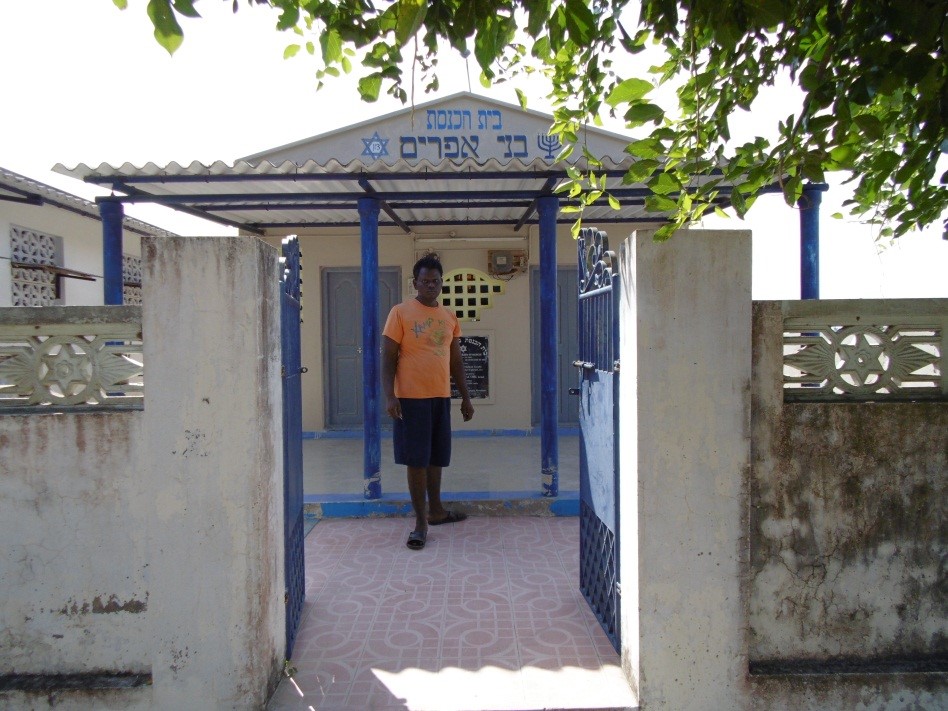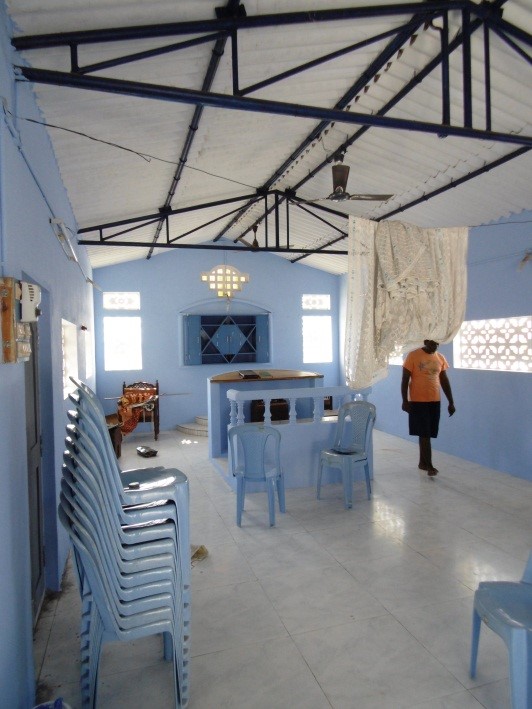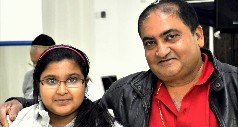BENE EPHRAIM SYNAGOGUE (2005)
1, Synagogue Street
Machilipatnam 521 001
Andhra Pradesh, INDIA
This is a functioning synagogue with a small congregation. The contact person is the friendly and helpful Sadok Yacobi at This email address is being protected from spambots. You need JavaScript enabled to view it.. To visit the two Bene Ephraim synagogues, it is most reasonable to travel to Vijayawada, the largest city in the Andhra Pradesh state. To reach the two buildings, which are in separate towns a modest distance away from Vijayawada, visitors should hire a car and driver. Whereas the other (more active) Bene Ephraim has a guest room available to visitors, it is quite basic. For those seeking greater comfort, a stay at the Gateway Hotel (of the Taj Group) in central Vijayawada is suggested.
The Bene Ephraim (Children of Ephraim), one of India’s distinct communities of Jews, are a group of fifty or so families living in a handful of towns and villages in the central part of Andhra Pradesh state of southeastern India. They are also referred to as the Telugu Jews because they speak the local language of Telugu. As practicing Jews, they form part of the Mala and Madiga regional tribes made up of people of different religions and faiths, the majority Christian. These tribes were restricted under India’s ancient caste system as dalits (meaning “broken to pieces”), or “untouchables,” an institution now outlawed by the country’s constitution although problems of discrimination persist.
According to an oral history recounted by the brothers and community leaders Shmuel and Sadok Yacobi, the Bene Ephraim are of an ancient origin. In the Jewish diasporic tradition begun more than two and one-half millennia ago, a group of Jews migrated from Persia into Afghanistan, Tibet, and China before arriving over one thousand years ago in India’s northernmost region of Jammu, Kashmir as well as the Magadha Kingdom, now part of West Bengal and the Northeastern Hill States. Some of these Jews came to settle permanently in the Northeastern Hills States of Manipur and Mizoram and later took the name B’nei Menashe. Others moved south to Orissa and Telugu land, today’s Andhra Pradesh, and they came to be known as Vrathyas, the root of Ephrathias, and the derivation of Ephraim. Oral tradition also reveals that these Jews, the ancestors of the current-day Bene Ephraim, settled on the bank of the Krishna River. In time they erected a synagogue in the village of Amaravathi. Years later this synagogue was destroyed, and a Buddhist temple followed by a Hindu temple was built on the site. Excavations carried out by the Indian Department of Archeology on the site of the former synagogue affirm, according to the Yacobi brothers, some type of Jewish presence in the area through copper plates dated to the second century CE.
Nearly two hundred years ago, Baptist missionaries from the United States arrived here and converted much of the local population to Christianity. However in 1981, a small group of these Baptists decided to return to their Jewish origins. The Bene Ephraim Jews have identified certain traditional practices of the Mala and Madiga tribes, connecting them to Jews of ancient times. Although other tribes who adopted Christianity bury their dead in a north-south orientation, those of the Mala and Madiga tribes of any faith bury their dead only east-westward (in the Jewish tradition, towards Jerusalem). When a child is born, a naming ceremony is conducted on the eighth day after the birth, which also draws from Jewish practice. When a girl reaches the age of eleven years and one day, or a boy the age of twelve years and one day, there is a coming of age ceremony when the child is considered an adult. This tradition is akin to the Jewish Bat Mitzvah (for the female) and Bar Mitzvah (for the male) rituals. In the view of the Yacobi brothers, there are other Jewish customs that penetrated Telugu culture. For example, the Telugu use a lunar-solar calendar similar to that of the Jews. Shmuel Yacobi also has conducted linguistic research of the Telugu language, and he has counted many words of Hebrew and Aramaic origin.
In recent years, two Bene Ephraim (Children of Ephraim) synagogues have been built in central Andhra Pradesh. One is a small building dating to 1991 in the village of Kotta Reddy Palem, near Chebrole in Guntur district. This second slightly larger and more recent structure, dedicated in 2005 and located in the town of Machillitatnam, stands on what is known as Synagogue Street. This building is an unassuming structure with simple building materials that include walls of rudimentary structural blocks neatly veneered in white chunam (plaster made of polished lime and sand) and a corrugated roof with cement. Another corrugated roof supported by thin painted blue steel columns forms a small front porch to the synagogue. This space is used for ceremonial and social purposes.
The exterior and interior of the synagogue have limited decoration and design flourishes, most noticeably the Magen David (Star of David) and menorah (candelabra) painted on the facade of the building. These applied features flank the painted name of the synagogue in Hebrew, and together they identify the building as one serving a Jewish purpose. Painted jali (perforated) panels – a distinct Indian architectural nod – versus glass windows units allow light and ventilation into the sanctuary. Wooden doors, also painted, lead into the prayer space, which is a rectangular shape.
The sanctuary is fitted out with a centrally-placed painted tebah (bimah), and plastic chairs fill the space. The chunam walls are painted a pleasing and cheerful periwinkle. As per Orthodox Jewish custom, men and women sit separately in the sanctuary. Here a curtain separates the two areas. Affixed to the west wall of the synagogue is the painted wood heckal, or ark. Its design incorporates a Magen David (Star of David). The sanctuary is finished with off-white ceramic tile floor pavers and an open ceiling with exposed metal trusses supporting the corrugated gabled roof. Fans hang from the ceiling, providing some cooling of the prayer space. This unpretentious and intimate-scaled synagogue is a special and well-maintained place that well serves the religious and social needs of a relatively isolated yet devout community. Some of its membership lives in houses along the street and in the immediate neighborhood.

Exterior

Interior








